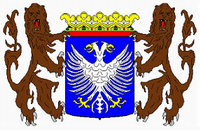Our location in Arnhem: Rijnkade (by the Nieuwe Kade)
For visit of schools or groups contact us.
Arnhem was first mentioned as such in 893 as Arneym or Arentheym, referring to the many eagles that inhabited the hills and forests of Arnhem back then. Traces of human residence date back much further, however. The oldest archeological findings of human activity around Arnhem are two firestones of about 70.000 years ago. This comes from the stone age, when the Neanderthals lived in this part of Europe. In Schuytgraaf, tracks of a hunter's camp have been discovered from around 5000 BC. In Schaarsbergen, 12 grave hills were found from 2400 BC, which brought the so-called Neolithic revolution to the area of Arnhem, i.e. the rise of the farmers.
The earliest settlement in Arnhem dates from 1500 BC, where traces have been found on the Hoogkamp, where the Van Goyenstraat is currently located. In the inner city, around the St. Jansbeek, traces of settlement have been found from around 700 BC, while the first traces south to the Rhine have been found dating around 500 BC, in the Schuytgraaf.
Though the early tracks of settlements did show that the early residents of Arnhem descended from the forests on the hills, Arnhem was not built on the banks of the river Rhine, but a little higher along the St. Jansbeek. Arnhem arose on the location where the road between Nijmegen and Utrecht/Zutphen split. Seven streams provided the city with water, and only when the flow of the Rhine was changed in 1530, was the city located at the river.
The city of Arnhem had its real origins in 1233 when Otto II, count of  Guelders from Zutphen, conferred city rights on the town, which had belonged to the abbey of Prüm, settled in, and fortified it. Arnhem entered the Hanseatic League in 1443. In 1473, it was captured by Charles the Bold of Burgundy. In 1514, Charles of Egmond, duke of Guelders, took it from the dukes of Burgundy; in 1543, it fell to the emperor Charles V. As capital of the so-called "Kwartier van Veluwe" it joined the Union of Utrecht in 1579 and became part of the Republic of the Seven United Provinces of the Netherlands in 1585. The French occupied the town 1672–74; from 1795 to 1813, it was reoccupied by the French, by both revolutionary and imperial forces. In the early 19th century, the former fortifications were almost completely dismantled, to give space for town expansion. The Sabelspoort (Sabresgate) is the only remaining part of the medieval walls. Guelders from Zutphen, conferred city rights on the town, which had belonged to the abbey of Prüm, settled in, and fortified it. Arnhem entered the Hanseatic League in 1443. In 1473, it was captured by Charles the Bold of Burgundy. In 1514, Charles of Egmond, duke of Guelders, took it from the dukes of Burgundy; in 1543, it fell to the emperor Charles V. As capital of the so-called "Kwartier van Veluwe" it joined the Union of Utrecht in 1579 and became part of the Republic of the Seven United Provinces of the Netherlands in 1585. The French occupied the town 1672–74; from 1795 to 1813, it was reoccupied by the French, by both revolutionary and imperial forces. In the early 19th century, the former fortifications were almost completely dismantled, to give space for town expansion. The Sabelspoort (Sabresgate) is the only remaining part of the medieval walls.
Source: http://en.wikipedia.org/wiki/Arnhem#History
|
|

